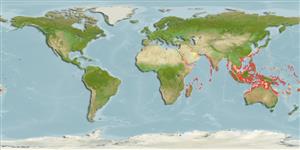>
Ovalentaria/misc (Various families in series Ovalentaria) >
Pomacentridae (Damselfishes) > Pomacentrinae
Etymology: Amblyglyphidodon: Greek, amblys = darkness + Greek, glyphis = carved + Greek, odous = teeth (Ref. 45335).
More on author: Bleeker.
Environment: milieu / climate zone / depth range / distribution range
экология
морской ассоциированный с рифами; немигрирующий; пределы глубины 2 - 45 m (Ref. 7247). Tropical; 35°N - 24°S, 32°E - 172°W
Indo-West Pacific: from the Eastern Indian Ocean; north to Ryukyu Is.; south to Indonesia, including Western Australia up to the Caroline and Marshall Is.
Size / Вес / Возраст
Maturity: Lm ? range ? - ? cm
Max length : 14.4 cm TL самец/пол неопределен; (Ref. 30504)
Краткое описание
определительные ключи | морфология | морфометрия
колючие лучи спинного плавника (общее число) : 13; членистые (мягкие) лучи спинного плавника (общее число) : 12 - 13; колючие лучи анального плавника: 2; членистые (мягкие) лучи анального плавника: 12 - 14. This species is distinguished by the following characters: D XII-XIII,12-13 (usually XIII,12); A II,12-14 (often II,13); pectoral rays 16-17; lateral line tubed scales 14-17; gill rakers total, 25-29; body depth is 1.5-1.8 in SL; colouration, silvery grey with paler scale centers and yellow belly, the anterior half of anal fin and anterior margin of soft dorsal fin and the upper and lower margins of caudal fin is blackish; upper pectoral fin base with a distinct wedge-shaped black mark (Ref. 82240).
Adults inhabit lagoons, reef passages, and the outer reef slopes as solitary individuals or in small groups. Feed on copepods, amphipods, mysids, fish eggs, crustacean larvae, and a small portion of algae (Ref. 7247). Oviparous, distinct pairing during breeding (Ref. 205). Eggs are demersal and adhere to the substrate (Ref. 205). Males guard and aerate the eggs (Ref. 205).
Life cycle and mating behavior
Maturities | размножение | Spawnings | Egg(s) | Fecundities | личинки
Oviparous, distinct pairing during breeding (Ref. 205). Eggs are demersal and adhere to the substrate (Ref. 205). Males guard and aerate the eggs (Ref. 205).
Allen, G.R. and J.E. Randall, 2002. A review of the leucogaster species complex of the Indo-Pacific pomacentrid genus Amblyglyphidodon, with descriptions of two new species. aqua, J. Ichthyol. Aquat. Biol. 5(4):139-152. (Ref. 82240)
Статус Красного Списка МСОП (Ref. 130435)
Угроза для людей
Harmless
Использование человеком
рыболовство: не имеет хозяйственного значения; аквариум: коммерческий
дополнительная информация
инструменты
Специальные отчеты
Скачать в формате XML
ресурсы в Интернет
Estimates based on models
Preferred temperature (Ref.
123201): 24.9 - 29, mean 27.9 °C (based on 666 cells).
Phylogenetic diversity index (Ref.
82804): PD
50 = 0.5005 [Uniqueness, from 0.5 = low to 2.0 = high].
Bayesian length-weight: a=0.01995 (0.01156 - 0.03445), b=2.95 (2.80 - 3.10), in cm total length, based on LWR estimates for this species & (Sub)family-body (Ref.
93245).
Trophic level (Ref.
69278): 3.4 ±0.39 se; based on food items.
устойчивость к внешним воздействиям (Ref.
120179): высокий, минимальное время удвоения популяции до 15 месяцев (Preliminary K or Fecundity.).
Fishing Vulnerability (Ref.
59153): Low vulnerability (10 of 100).
Nutrients (Ref.
124155): Calcium = 95.7 [46.9, 147.0] mg/100g; Iron = 0.78 [0.46, 1.29] mg/100g; Protein = 18.3 [17.1, 19.4] %; Omega3 = 0.123 [0.073, 0.207] g/100g; Selenium = 25.1 [12.9, 48.9] μg/100g; VitaminA = 142 [42, 461] μg/100g; Zinc = 1.33 [0.88, 1.92] mg/100g (wet weight);
